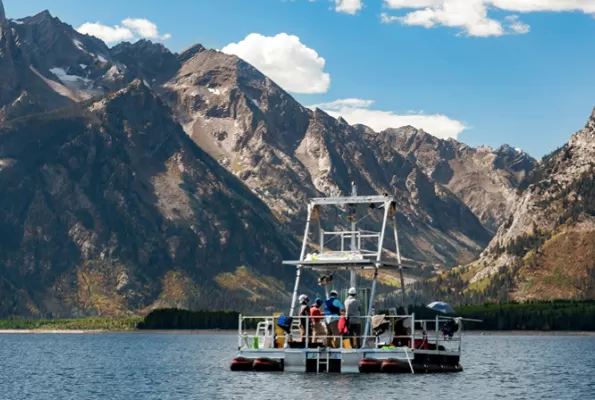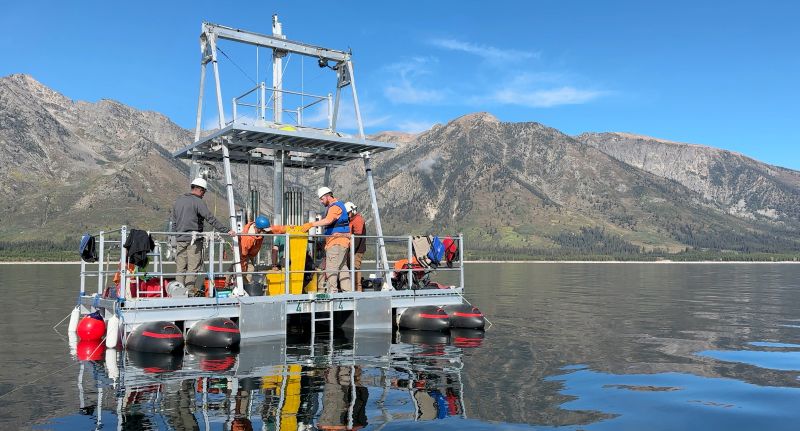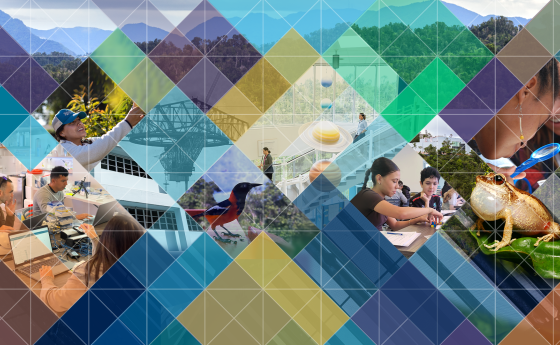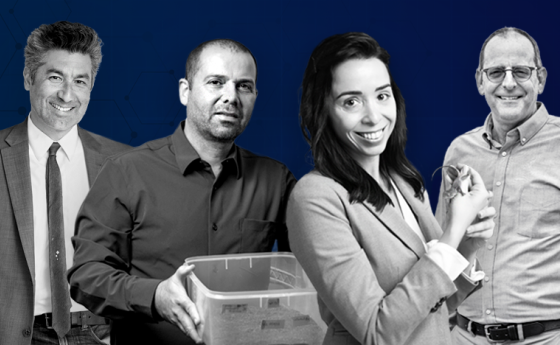
From collecting cores, braving blizzards and measuring microbes, students do it all
Whether they’re on a boat in the middle of a lake to extract sediment cores, deploying a weather balloon in the middle of a blizzard, or sailing around the Aleutian Islands to study microbes in the deep sea, university students play a vital role in advancing science supported by the U.S. National Science Foundation.
Collecting cores
In September 2023, Ryan Thigpen, Mike McGlue, their students and a team of coring experts anchored a platform in the middle of Jackson Lake in Grand Teton National Park and extracted a 100 foot-long-tube of sediment from water depths greater than 400 feet.
That sediment core could reveal evidence for more recent earthquakes along the Teton fault, which the team has suggested may extend well into and potentially even across the Yellowstone caldera. This giant crater first formed following a huge eruption 2.1 million years ago. The last known significant quake recognized along the fault occurred approximately 5,000 years ago, and geologic evidence indicates that before this, Teton earthquakes may have happened every 2,000 or 3,000 years.
Thigpen and McGlue, along with co-investigators Ed Woolery, Summer Brown and Kevin Yeager, are professors at the University of Kentucky. They are collaborating with experts from the NSF-supported Continental Scientific Drilling Facility at the University of Minnesota to study the region’s seismic and climate history.
"The coolest thing about this project is that it not only involves so many fellow faculty members but also brings in students from undergraduates to PhD students," Thigpen said. "I love working with students and taking them to cool places."
When this project concludes, it will live on in an NSF Established Program to Stimulate Competitive Research (EPSCoR) Track 1 project to combat climate change in Kentucky. "Our Teton project helped provide students with skills and training that they can continue to refine and apply in the EPSCoR project," Thigpen said.
Braving blizzards
"I can't believe it!" shouted Kaitlyn Jesmonth, holding her phone against a dripping windowpane. She had captured the precise moment lightning hit a steam stack tower in the middle of blizzard conditions in upstate New York.
Jesmonth has been studying how wind turbines can intensify lightning during lake-effect storms. A team that included several students launched 16 Prius-sized weather balloons near Lake Ontario. The balloons were equipped with instruments to measure electrostatic charge, temperature, humidity and windspeed as snow fell and lightning lit the sky.
"I was a forecaster for the project," said Jesmonth, who contributed to the project as an undergraduate and is now a second-year master's student at the University of Illinois Urbana-Champaign. "I looked at the radar, provided 15-to-30-minute forecasts to help inform the team preparing equipment and made sure we launched the electric field meter inside the lake effect band to measure the electric field."
Lake effect storms occur when cold air passes over warmer water, picking up warmth and moisture and fueling huge rainfalls and localized snowstorms. "This work can help inform weather forecasts and protect wind turbines from damage," said Scott Steiger, a professor at the State University of New York at Oswego who is leading the project.
Measuring microbes
Deep in the ocean, a community of creatures, including tube worms and mussels, relies on methane for energy. Too far from the sun to directly benefit from photosynthesis, these animals inhabit methane seeps, which are areas where methane bubbles from rocks into ocean water.
"We're comparing methane seeps on the continental margins of Southern California — 1,500 meters [just under a mile] deep — to the deepest known seeps in Alaska, which are 5,000 meters [just over 3 miles] deep," said Victoria Orphan, a professor at the California Institute of Technology and lead scientist on a project to better understand seep environments.
Orphan and her co-principal investigators, Lisa Levin with Scripps Institute of Oceanography, Tina Treude with UCLA and Shana Goffredi with Occidental College, want to know how the footprint of methane, a potent greenhouse gas, determines the fate of deep-sea organisms and microbes along continental margins. During a research cruise expedition off the Aleutian Islands in Alaska, the researchers used various tools to understand how microbes consume methane under different oxygen levels and pressures.
The team not only brought in undergraduate and graduate students from their institutions but also recruited an Alaskan undergraduate to participate in the research via the Alaska Native Science and Engineering Program (ANSEP).
Stefani Martinez, an undergraduate from the University of Alaska, Anchorage, who is Yup’ik and Otomi, went on the research cruise off the Aleutians. As the only Alaskan Native on the expedition, Martinez said she felt honored. "I was able to share cultural knowledge with my shipmates, and it was exciting to see people excited about Alaska," she said.
Collaborating and sharing knowledge with her crew highlighted the importance of combining Indigenous knowledge and Western science. "We call it two-eyed seeing," Martinez said.
The research team also participated in ANSEP's annual Career Exploration in Marine Science workshop to engage middle school students with themed activities including deep-sea animals, plankton diversity and geology. Martinez attended ANSEP as a participant and is now a staff member. "I was that middle school student a few years ago, and now it's the other way around. It's really fun," Martinez said.
Calling all students
In addition to supporting principal investigator-led NSF projects, high school, undergraduate and graduate students, as well as postdoctoral researchers, can also directly seek opportunities with NSF.
For high school, undergraduate and post-baccalaureate students, visit this NSF 101 on funding opportunities. Although many of these opportunities require a principal investigator to submit the grant proposal on behalf of the student, some programs allow students to submit proposals independently.
For graduate students and postdoctoral researchers, check out this NSF 101 on funding opportunities. It provides many research opportunities that include stipends. Some cover many disciplines, like the NSF Graduate Research Fellowship Program (GRFP), and others are more specialized, like the Earth Science Postdoctoral Fellowship.
For students who live in EPSCoR states, NSF recently published an NSF 101 on funding opportunities guide for the new EPSCoR Graduate Fellowship Program, which supports the pool of talented individuals who received Honorable Mention from GRFP within the last three years.








